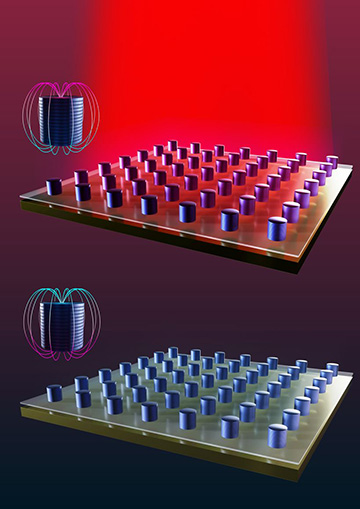
A plasmonic laser is turned on (top) and off (bottom) by switching the magnetization of a nanodot array. The zoomed insets show the magnetic field around a single nanodot. [Image: J. Rantala]
Plasmonic nanolasers, first described in 2009, are already employed in surface-enhanced Raman spectroscopy and other biosensors. Now a research team in Finland has improved the technology further by inventing a magnetic on-off switch for such nanolasers (Nat. Photon., doi:10.1038/s41566-021-00922-8).
The scientists at Aalto University, Finland, replaced the noble metals used in most earlier plasmonic nanolasers with tiny dots made of two metals with stronger reactions to external magnetic fields. The new type of control could lead to better on-chip signal processing and new explorations into the field of topological photonics.
How the nanolaser works
The Aalto team built several periodic arrays of nanodots upon a substrate of gold and a silicon dioxide insulator. Instead of making the dots out of magnetism-repelling gold, though, the researchers built cylindrical towers of alternating thin layers of platinum and cobalt, 220 nm in diameter and 68 nm in height. (Platinum is paramagnetic, while cobalt is ferromagnetic.) The lattices had a periodicity of 590 nm in both x and y directions for square arrays and of 520 to 540 nm in the y direction for rectangular arrays.
During fabrication, the scientists immersed the nanodots in an infrared laser dye solution called IR-140. The team turned an array into a laser by exciting it with left- or right-circularly-polarized 200-fs pulses of 800-nm radiation; the output light had a peak wavelength of roughly 890 nm.
“These plasmonic lasers operate in many ways like a regular laser,” says Päivi Törmä, a physicist who heads Aalto’s quantum dynamics group. “The gain medium is dye molecules in a solution, placed close to the array, and the ‘resonator’ is the existence of a band edge, which provides feedback (this principle is similar to what is widely used in usual distributed-feedback lasers).”
As the researchers reversed the magnetic field, they found that the lasing threshold and intensity changed depending on the magnetization direction. Indeed, at a pump fluence just above the lasing threshold, the team reportedly could modulate lasing intensity by as much as 75%–90% by magnetic switching—effectively creating an on–off switch.
A topological-photonics platform?
Digging into the magnetic switching’s effect on the laser’s behavior, the team also observed evidence of splitting between two opposite chiral lasing modes. This sort of splitting by time-reversal symmetry breaking (that is, magnetization direction) is, according to the paper, “needed in creating topologically non-trivial systems.”
Photonic analogues of so-called topological insulators in condensed-matter physics have been a hot topic for a number of years (see “Topological Photonic Systems,” OPN, May 2018). Topological photonics could, it’s thought, potentially allow new kinds of signal processing and other applications that are robust to disorder, material defects and external disruptions. And the Aalto group thinks that their magnetically controlled nanolasers could prove “an exciting platform” for studying such topological effects.

Päivi Törmä. [Image: Aalto University]
“The chiral modes and other chiral effects that we see reflect the strong effect of time-reversal symmetry breaking that the particle magnetization produces, and this symmetry breaking, combined with a suitable lattice geometry, can later be utilized to produce topological systems,” Törmä says. “It is important that the existence of the array structure and corresponding lattice modes was found in our work to amplify the expected effects of the magnetization—this is remarkable and gives the promise for topological studies later.”
Törmä emphasizes that she and her colleagues have not yet achieved non-reciprocal lasing, which occurs when the time-reversal symmetry of the system is broken. However, she says, it probably can be observed in future variation on this type of nanolaser.
Pursuing applications
The next step for Törmä and her collaborators is to build actual topological photonic systems. “Magnetic switching can be used as a control mechanism in any plasmonic nanolaser of this type,” she says. “If one starts to pursue such applications, they could be feasible within a few years, as this is already on-chip technology.”
According to Törmä, the biggest hurdle in getting to such integrated nanolasers in real applications will be to achieve an electrically pumped rather than optically pumped system. If that’s accomplished, though, she envisions a number of potential uses for these diminutive, magnetically switched lasers. “Plasmonic nanolasers could be used in sensing, for instance, since the lasing phenomenon amplifies even tiny changes in the mode structure (caused by the thing that one wants to detect).”
